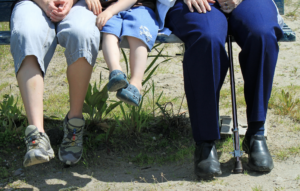2.16: Generations
- Page ID
- 48599
Learning Objectives
- Discuss generational diversity in the workplace
We have generational differences in the workplace with Baby Boomers, Generation X, Generation Y and Generation Z employed together. While we can recognize the differences within and among these working generations, we also need to discuss why it is important to have these multiple perspectives in the workplace. There are both benefits and challenges to having a wide variety of generations working within an organization. Let’s get exploring!
Building a Product TEam
 You are the manager of a marketing department and it is your job to assemble a team to introduce a new product to the market.
You are the manager of a marketing department and it is your job to assemble a team to introduce a new product to the market.
How do you choose your team? Do you pick a team who is all in the same age range and would use the product you are marketing? Or would you choose a mix of ages to incorporate each generation? There is no right or wrong answer here, but whichever team you chose would influence the path to your team’s success.
It would make sense to choose people who would actually use the product to ensure you understand the generation you are marketing to. However, it would be equally as important to include people from other generations to balance out the team. Why do those perspectives matter? There is value in both experience and youth. For example, a person’s perspective brings a level of expertise to the table that has been honed over years of hard work and life lessons. A young person, on the other hand, can bring a fresh perspective to the workforce. They may have just entered into the workforce with the newest training and information available. Both the experienced and the youthful members of the workforce have something valuable to contribute. As a manager who is in charge of building a team, it is imperative that you help your diverse employees work together in order to be successful bringing the new product to market.
Now that we’ve looked at a case study involving examples from the workplace, let’s view generational diversity in a different light. A lot of generational differences may actually be stereotypes of how others view the other generation. Like many stereotypes, there is usually a reason behind its creation, however it is by no means always correct or all encompassing. It is unfair to assume that every member of one generation feels the same way about work-life priorities, other generations, or technology.
PRactice Question
So, the question becomes, what use is generational diversity as a valid way to categorize all members of the workforce? Are there better more effective ways to understand individuals? As we discussed above in the marketing case study, having diverse experiences and perspectives may make your teams more effective.
Learn More
Leah Georges, a social psychologist who studies generational differences, challenges the ideas about generational differences. We’ve discussed common common generational differences in the United States and she mentions in her TEDx talk “How Generational Stereotypes Hold Us Back at Work” are different in other parts of the world. Pay attention to what she says about stereotypes and what we can learn from Internet searches. She makes the claim that we have more similarities than we do differences.
What do you think? Take notes as you watch Georges and then decide the best way to approach generational diversity in the workplace!
Contributors and Attributions
- Generations. Authored by: Freedom Learning Group. Provided by: Lumen Learning. License: CC BY: Attribution
- Generation Gap. Authored by: Frantic1892. Provided by: Flickr. Located at: https://www.flickr.com/photos/nolittlepill/5896338584/. License: CC BY-SA: Attribution-ShareAlike
- How Generational Stereotypes Hold Us Back. Authored by: Leah Georges. Provided by: TEDxCreightonU. Located at: https://www.youtube.com/watch?v=dKNu5ZnWhb4. License: Public Domain: No Known Copyright


